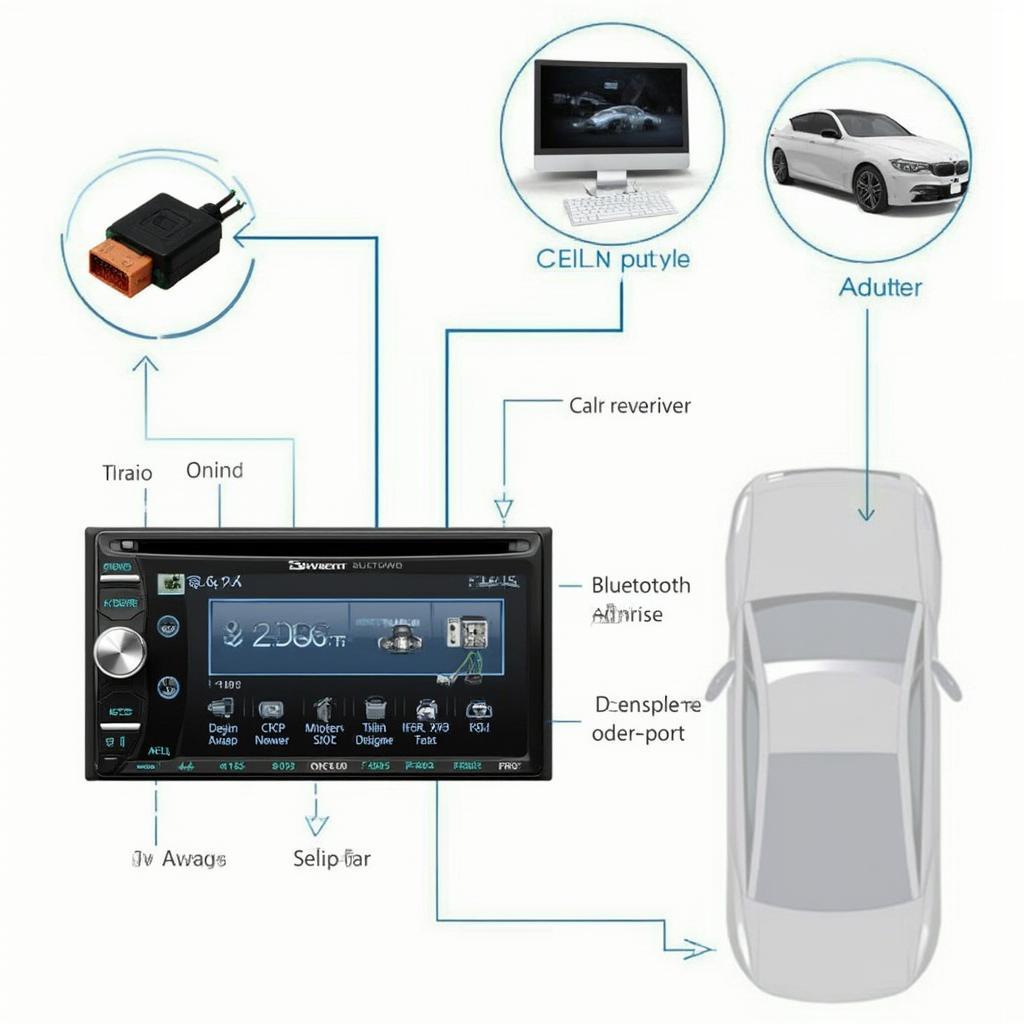Connecting your OBD2 scanner to your car stereo can unlock a wealth of information about your vehicle’s performance, diagnostics, and even control certain features. This guide will delve into the methods, benefits, and potential challenges of obd2 connect stereo integration.
Want to monitor your car’s vital signs in real-time on your stereo display? An OBD2 connection can make that a reality. From tracking fuel efficiency to diagnosing engine trouble codes, the possibilities are vast. We’ll explore different approaches to achieving this connection, whether you’re using an iPhone, Android device, or a dedicated car stereo system. You can learn more about specific solutions for iPhone integration by visiting our guide on iphone car stereo dash command obd2.
Understanding the OBD2 and Car Stereo Connection
Why would you want to connect your OBD2 scanner to your stereo? This connection bridges the gap between your vehicle’s diagnostic system and your entertainment hub, allowing you to view vital data without the need for a separate device. This data can range from simple metrics like speed and RPM to more complex diagnostics such as engine codes and coolant temperature.
Benefits of OBD2 to Stereo Integration
- Real-time Data Display: Monitor your vehicle’s performance metrics directly on your car stereo’s screen.
- Enhanced Diagnostics: Quickly identify and address potential issues with easy access to diagnostic trouble codes (DTCs).
- Improved Fuel Efficiency: Track your driving habits and make adjustments to optimize fuel consumption.
- Customizable Displays: Tailor the information displayed on your stereo to suit your specific needs.
- Convenient Access: All your vehicle information is readily available on a familiar interface.
Different Methods for Connecting OBD2 to Car Stereo
There are several ways to connect your OBD2 scanner to your car stereo. The method you choose depends largely on the type of stereo you have and your budget.
- Bluetooth OBD2 Adapters: These adapters plug into your OBD2 port and transmit data wirelessly to your stereo via Bluetooth. This is a popular and generally affordable option.
- Direct Connection Cables: Some stereos offer a direct connection for OBD2 scanners via a specific cable. This option provides a stable connection, but might be less common.
- Smartphone Integration: Using apps and a Bluetooth OBD2 adapter, you can display OBD2 data on your phone, which can then be mirrored or projected onto your car stereo screen. Check out our guide on how to connect obd2 to car stereo for more information.
- Dedicated OBD2 Car Stereos: Some aftermarket car stereos come with built-in OBD2 functionality.
Troubleshooting Common OBD2 Stereo Connection Issues
While connecting your OBD2 scanner to your stereo is usually straightforward, you might encounter some issues. Here’s how to troubleshoot some common problems:
- Bluetooth Pairing Issues: Ensure your stereo and Bluetooth adapter are discoverable and correctly paired. Refer to your stereo and adapter manuals for specific instructions.
- Data Display Problems: Check that the app or software you’re using is compatible with your OBD2 adapter and stereo. Ensure the correct data parameters are selected for display.
- Connection Drops: A weak Bluetooth signal can cause connection drops. Try repositioning the OBD2 adapter or your phone for a better signal. You might also consider a higher quality Bluetooth adapter. If you are experiencing trouble codes, especially the U0073 code, you can find more information on our website, obd2 code u0073.
Expert Insights
- John Smith, Automotive Electronics Engineer: “Connecting your OBD2 to your stereo is a fantastic way to gain deeper insights into your vehicle’s performance. It’s like having a constant health check for your car.”
- Jane Doe, Certified Mechanic: “The ability to see real-time data directly on my stereo screen is incredibly helpful for diagnostics. It saves me time and allows me to address issues quickly.”
Conclusion
Connecting your obd2 connect stereo setup opens up a new dimension in vehicle monitoring and diagnostics. By following this guide, you can successfully integrate your OBD2 scanner with your car stereo and unlock the wealth of information it provides. Remember to choose the method that best suits your needs and budget. For those using Android devices, we have a comprehensive guide available on android car stereo obd2.
FAQ
- Is it difficult to connect an OBD2 scanner to a car stereo? Not usually. Most connections are straightforward, especially with Bluetooth adapters.
- What kind of data can I see on my stereo with an OBD2 connection? You can see various data, including speed, RPM, fuel consumption, engine codes, and more.
- Do I need a special car stereo to connect an OBD2 scanner? No, you can use Bluetooth adapters or smartphone integration with many standard stereos.
- Are there any risks associated with connecting an OBD2 scanner to my car stereo? As long as you use a reputable adapter and follow instructions, the risks are minimal.
- What should I do if I encounter connection problems? Check your Bluetooth pairing, app compatibility, and connection strength. Refer to the troubleshooting section above.
- Can I control my car’s functions through the OBD2 connection on my stereo? Some apps and stereos allow for limited control, but this varies depending on the vehicle and system.
- Where can I find more information on specific OBD2 codes? You can find more information on specific codes, such as the Joying OBD2 code, on our website joying obd2 code.
For further assistance or inquiries, please contact us via WhatsApp: +1(641)206-8880 or Email: [email protected]. Our customer support team is available 24/7.


